The Arts on Stamps of the World — December 8
An Arts Fuse regular feature: the arts on stamps of the world.
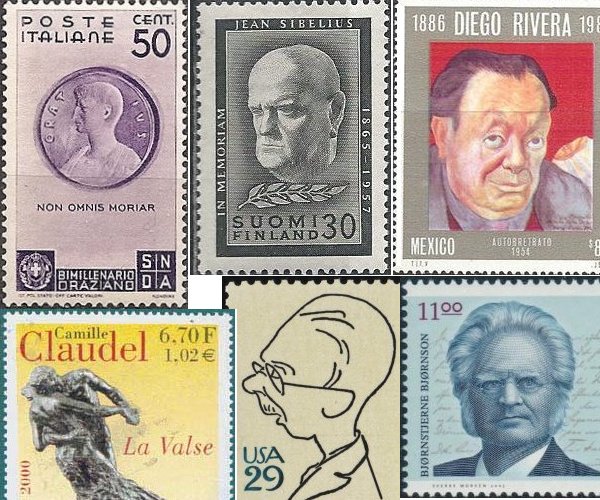
By Doug Briscoe
Well, we have quite an impressive line-up for December 8, the birthday of Horace, Jean Sibelius, Diego Rivera, Bjørnstjerne Bjørnson, Georges Méliès, Camille Claudel, James Thurber, Sammy Davis Jr, Bohuslav Martinů, Lucian Freud, Maximilian Schell, Jim Morrison, the architect of the White House, and the creator of Popeye, for starters.
For the 2000th anniversary of the birth of Quintus Horatius Flaccus (December 8, 65 BC – November 27, 8 BC), Horace, to you and me, Italy in 1935 issued an imposing set of stamps, each including a quotation from the works, mostly the Odes, of the great lyric poet. I confess that the only one I immediately recognized was, “Dulce et decorum est pro patria mori,” aptly illustrated by the Dying Warrior from the Temple of Aphaia at Aigina (the gray stamp, second row, fourth from right). The famous line, a little research tells me, is sourced in the Odes, Book III, no. 2, line 13. The others are as follows. The quotation on the green 10 centesemi stamp comes from the Centennial (or Secular) Hymn, line 29: “Fertius frugum pecorisque Tellus” (“the earth, so fertile in crops and cattle”—or sheep, as the case may be). The red 20 centesemi stamp offers, “Diffugere nives, redeunt iam gramina campis arboribusque comae” (Odes, IV.7.1. “The snows are fled away, leaves on the trees and grasses in the meadow renew their birth). On the 75, repeated on the blue stamp in the second row, we have “stet Capitolium fulgens” (III.3.42. “Let the [proud] Capitol [gleaming] in glory stand”). The heroic figure on the 30 accompanies “impavidum ferient ruinae” (III.3.8. “unafraid he would stand under the collapsing ruins”). The medallion aptly places the laurel wreath on the poet, “Me doctarum hederae praemia frontium” (I.1.29. “The ivy, the reward of the learned brow, sets me with the gods above”). Finally, “Non omnis moriar” (III.30.6. “I shall not altogether die”). The other two stamps come from Romania and San Marino, the latter in a jocular mood.
Most of the stamps for Jean Sibelius (8 December 1865 – 20 September 1957), as you might suspect, are of Finnish origin. The first exception—third from left—is a Romanian issue of 1965, the hundredth anniversary of the great composer’s birth (it happens to come from exactly the same set as the Romanian Horace issue above); and the second, at top right, issued just two years ago for the sesquicentennial, consists of a stamp and a souvenir sheet (not shown to scale) from Portugal. (Issued on the same day as the Sibelius was an Elisabeth Schwarzkopf souvenir sheet and stamp. We’ll see them on her birthday, which is tomorrow!) The very first Sibelius stamp appeared on the occasion of his 80th birthday in 1945; the next one came out shortly after his death in 1957. For the centennial, Finland issued a pair with the composer’s silhouette on one, and a further set of six is dated 2004. These depict a) a portrait of the composer by Akseli Gallen-Kallela; b) the composer’s hands at the keyboard; c) swimming swans, invoking the gorgeous tone poem “The Swan of Tuonela”; d) Sibelius’s home at Ainola; e) juxtaposed portraits of Sibelius and his wife Aino (she was the sister of composer/conductor Armas Järnefelt; and f) a page from the score of his “Voces Intimae” String Quartet. Finally, there is a 2002 stamp for the Sibelius Monument (titled Passio Musicae) sculpted by Eila Hiltunen in 1967.
Its’ the birthday of another great figure from the North, Bjørnstjerne Bjørnson (1832 – 26 April 1910), who won the 1903 Nobel Prize for Literature. Though primarily recognized as a poet (Edvard Grieg, Carl Nielsen, Frederick Delius, Christian Sinding, and Wilhelm Peterson-Berger are some of the many, mostly Scandinavian composers who wrote songs to his poems), Bjørnson also wrote quite a few novels and plays. Grieg also left unfinished an opera after Bjørnson, Olaf Trygvason. Bjørnson is also noted for his lyrics to the Norwegian national anthem, “Ja, vi elsker dette landet“, with music by his young cousin Rikard Nordraak.
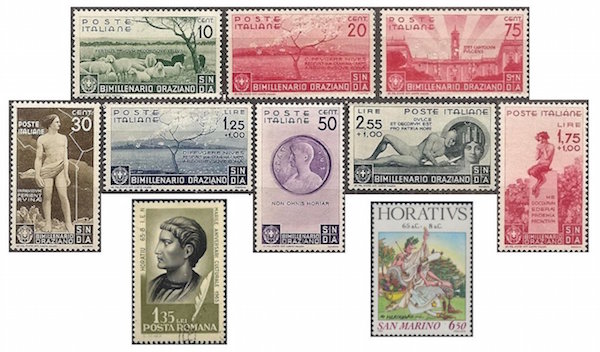
Mexico claims the lion’s share of stamps for native son Diego Rivera (December 8, 1886 – November 24, 1957), whose full name was (take a breath) Diego María de la Concepción Juan Nepomuceno Estanislao de la Rivera y Barrientos Acosta y Rodríguez. We begin with a 1954 Self-Portrait and continue with a set of three stamps showing Paisaje Zapatista (1915), Nude with Calla Lilies (1944), and Dream of a Sunday Afternoon in Alameda Park (1947-48). From Togo come Flower Carrier (1935) and Sugar Cane (1931). The Mexican stamp encouraging immunization uses Rivera’s Vaccination, and the stamp from Palau presents a detail from Landscape (1911). The stamp at the right of the second row shows a segment of the muralThe People in Demand of Health. Beneath it, on the Ecuadorean stamp, we see a detail from Controller of the Universe (originally titled, Man at the Crossroads, 1934). Finally, at lower left, are a couple of Rivera designs used for stamps promoting the 1968 Mexico City Olympics.
While we’re in Mexico let’s turn to the excellent composer Manuel Ponce (1882 – 24 April 1948). He was recognized with a handsome large stamp issue in 1974. Ponce wrote not only songs—the most famous being “Estrellita” of 1912—and folk song arrangements but piano music and a small but well-crafted body of chamber and orchestral scores, including a violin concerto that was recorded by Henryk Szeryng.
Today’s earliest figure, other than Horace, is also a composer, František Xaver Dušek (or Franz Xaver Duschek; baptized 8 December 1731, d. 12 February 1799). On the stamp he is shown with his wife, soprano Josefína Dušková (Josepha Duschek). The Dušeks were friends of Mozart, and the stamp is one of a set commemorating Mozart’s bicentenary in 1956, with a concentration on his 1787 visit to Prague. Dušek was a keyboard virtuoso who also wrote many wind pieces and symphonies.
The Irish architect who designed the White House in Washington, D.C., James Hoban, was born in 1755 and died on this day in 1831. He came from County Kilkenny and worked in his youth as a wheelwright and carpenter, later turning to drawing, at which he excelled. He came to the US after the Revolutionary War and set up shop as an architect in Philadelphia. Two years later, 1787, he had relocated to South Carolina, where some of his work was admired by George Washington. Hoban won the contract to design the White House in 1792. He also assisted on the Capitol building and lived the rest of his life in Washington, D.C.

Probably the two most important painters in 19th-century Germany were Caspar David Friedrich and Adolph von Menzel (December 8, 1815 – February 9, 1905). Menzel began life without the noble “von”, earned along with his knighthood in 1898. He was born in Breslau to a lithographer father. Though he traveled and was not unwilling to mingle with his peers, Menzel seems to have felt himself isolated, perhaps because of his unusually small stature of about four foot six inches. His work was admired by Degas, who at one point referred to Menzel as “the greatest living master”. Besides the portrait stamps, we can enjoy three of Menzel’s works, Frederick the Great in Sanssouci (1850-52), The Balcony Room (1845), and a drawing, The Cobbler.
The Serbian journalist and novelist Jakov Ignjatović (in-YAH-to-vitch, 8 December 1822 – 5 July 1889) also wrote in Hungarian. Ignjatović was politically active, fought alongside Hungarian forces in the Revolution of 1848, and later worked for educational equality for Slavic and Romanian people living in the Austro-Hungarian empire. He did not turn to the novel until rather late in his life, but his plots are said to be inventively worked out and his dialogue authentic and rich.
Italian realist painter Silvestro Lega (8 December 1826 – 21 September 1895) was also active in the revolutionary movement of 1848, joining Garibaldi in the bid for Italian independence. He had studied painting in the years leading up to that momentous struggle, but didn’t paint his first large scale canvas, a Doubting Thomas, until 1850. His most representative works, though, would be genre pictures. The stamp gives us a look at his canvas The Visit (1868). Lega’s middle years were clouded by the deaths of his lover Virginia Batelli and three of his brothers, as well as by financial troubles. Toward the end he lost most of his eyesight. I like his charming Il canto di uno stornello (The Singing of a Ditty, 1868), which probably portrays members of the Batelli family, with whom Lega resided in his happier years. He never left Italy.
A visual artist of a very different kind was the great pioneer of film Georges Méliès (8 December 1861 – 21 January 1938). As a child he preferred to draw pictures during class, built puppet theaters, and, as a teen, progressed to marionettes. He became fascinated by magic tricks and became adept at them. When his father sold the family business, Méliès used his share to buy a theater and spent more time as a producer, writer, director, and set and costume designer than he did on the stage. On witnessing a presentation by the Lumière brothers in 1895, Méliès naturally fell under the spell of the new medium of film. The brothers refused to sell him their cinematograph, so he traveled to London and bought one of Robert W. Paul’s Animatographs instead. From that point Méliès set out on his course of designing and directing 500 brilliant short films, ranging in length from one minute to forty minutes, most of them using elaborate devices to produce illusions. The most famous of these today is surely A Trip to the Moon (1902). Many of his films were lost to confiscation by the French army for the war effort—they were melted down for their silver and celluloid content and made into heels for boots—and to Méliès’s own destructive rage when Pathé took over his studio in 1923. Despite these losses, there are still some 200 Méliès films extant, and most or all of them can be seen on DVD. Recently, Méliès was resurrected (in the person of Ben Kingsley) in Martin Scorsese’s Hugo (2011), based on Brian Selznick’s 2007 novel The Invention of Hugo Cabret. Just last year, a two-minute Méliès film, Match de prestidigitation, long believed lost, was rediscovered in a Czech Film Archive.
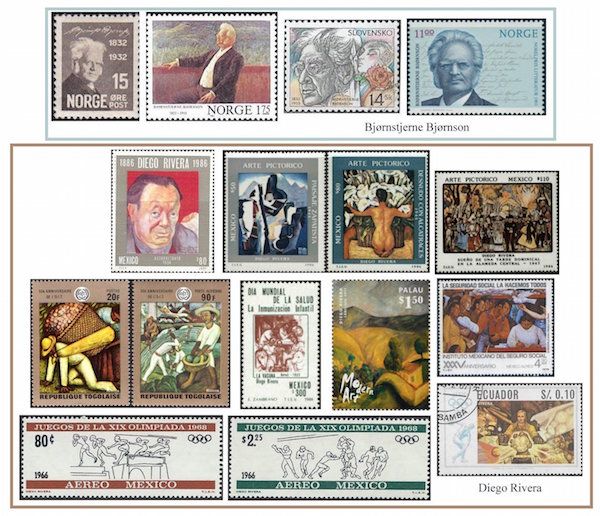
The second of four consecutive French visual artists in today’s line-up is Aristide Maillol (1861 – September 27, 1944), a sculptor, painter, and printmaker. His determination to become a painter overcame rejections from schools and a hand-to-mouth existence when he was at last admitted to the École des Beaux-Arts in 1885. There his teachers included Jean-Léon Gérôme and Alexandre Cabanel. Gauguin and Pierre Puvis de Chavannes (whose birthday is next week) were among his early influences. Maillol followed Gauguin’s advice to work in the decorative arts, and Maillol turned, first, to tapestry design and then to terracotta sculpture. Maillol also made woodcut book illustrations. Almost the entirety of Maillol’s mature work in both sculpture and painting was in studies of the female form. The centennial stamp from 1961 shows his Mediterranean (1905), now in the Tuileries. Three of his pieces now stand in the Metropolitan Opera House, one of them called Kneeling Woman: Monument to Debussy (1930-33). An example of his painting is Pensive (1893, the influence of Gauguin is plain), and a rare male nude is Young Cyclist (Le coureur cycliste, 1907-09). Aristide Maillol was a passenger killed in a car accident at the age of 83.
Speaking of Debussy, we note that he had a close (possibly physical) relationship with another French sculptor, Camille Claudel (8 December 1864 – 19 October 1943), whose name has been made more familiar to modern audiences by the films in which she is portrayed by Isabelle Adjani (1988) and Juliette Binoche (2013). She was, of course, the lover of Rodin and the sister of poet Paul Claudel. She came to Paris from the north of France at the age of sixteen. Determined to become a sculptor, but denied entry to the École des Beaux-Arts on account of her sex, she studied with Alfred Boucher and then, in 1884, with Rodin. Their love affair lasted until 1892, ending, some have suggested, because of artistic rivalry between them. Though Claudel did suffer from mental illness, destroying much of her work in 1905, consensus is that she should not have been confined to an institution for the last thirty years of her life. Doctors were unable to persuade Claudel’s mother, who never once visited her in all those years, nor her brother Paul, whose visits totaled a mere seven, to release her. One of Claudel’s most famous works is La Valse (or The Waltzers, conceived in 1889, cast in 1905), shown on the French stamp of 2000. This very year a national Camille Claudel Museum opened in Nogent-sur-Seine, one of her childhood homes.
French visual artist #4 is Albert Gleizes (8 December 1881 – 23 June 1953), who claimed to be the founder of Cubism. Certainly he and Jean Metzinger “wrote the book” on the subject, Du “Cubisme”, in 1912. He took part in the 1913 Armory Show and served for about a year in World War I, organizing entertainments for the troops. He and his wife spent much of the remainder of the war in New York. In the 1920s and 30s Gleizes devoted much time to theoretical writing. The couple remained in France during World War II. Both the stamps portray Gleizes’s earlier work, Le Chant de guerre (Portrait de Florent Schmitt, 1915) and Sur des clowns (1917).
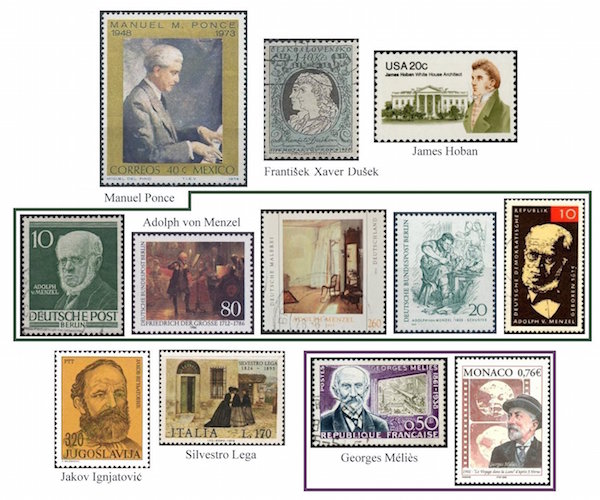
We travel not far now, to Belgium, for the painter, lithographer, and illustrator Antoine Carte, called Anto-Carte (1886 – 13 February 1954). Born at Mons, he studied in Paris on a scholarship. His style embodies symbolism, expressionism, and naturalism and typically focuses on the lives of workers, religious subjects, and, later, acrobats and harlequins. In 1928 he co-founded the Groupe Nervia, a Walloon response to Flemish expressionism. Carte taught at the Brussels Academy of Fine Arts from 1932, notably the art of stained glass. He also designed Belgian banknotes and stamps. The first of these that we see here, not at all typical of the artist’s accustomed style, was issued in 1922 to benefit invalided soldiers, the later, blue one from 1954, much more typical of the artist’s work, titled The Blind Man and the Paralytic, was for combating tuberculosis. Note that these stamps are what we philatelists call “semi-postals”, stamps issued with surcharges that go to support various causes. The practice is very common elsewhere in the world, less so in the United States, though just last week the USPS issued one in support of Alzheimer’s research. (Its cost is 60¢, 49 for postage, 11 for research.) The newer stamp gives us Carte’s Le Partage du Pain (The Breaking of the Bread, undated). For more on Anto-Carte (in French), see the website Les Amis d’Anto-Carte.
Czechoslovakia twice honored native son Bohuslav Martinů (December 8, 1890 – August 28, 1959) on stamps: in 1965 and 1990. Martinů was a prolific composer active in many genres. During the war he lived in the United States, for much of that time in Great Barrington, and he taught at the Berkshire Music School in the summer of 1946. A recent study concludes that Martinů may have been an Asperger syndrome sufferer.
American humorist and journalist James Thurber (December 8, 1894 – November 2, 1961) was a mainstay of The New Yorker from 1927. Born in Columbus, Ohio, Thurber lost an eye in childhood in a game of William Tell he was playing with his brother. (“Cut that out, you kids. You could put somebody’s eye out.”) He worked as a reporter for the New York Evening Post when he first moved to Greenwich Village in 1925. Thurber’s collected writings possess an evergreen wit and sophistication. In his final year he suffered from a blood clot on the brain that affected his behavior. He survived the operation but succumbed to pneumonia.
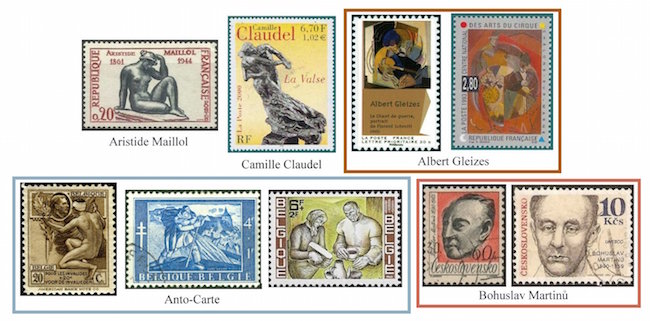
An American cartoonist of a lighter stripe was E(lzie) C(risler) Segar (SEE-gar, December 8, 1894 – October 13, 1938), the creator of Popeye. Segar was born in Illinois and was musical, playing accompaniments in the theater for films and vaudeville acts and giving the occasional performance at the local opera house. He also worked as a projectionist. He was 18 when he decided to become a cartoonist and took a correspondence course to that end. In Chicago he met Richard F. Outcault, the creator of The Yellow Kid and Buster Brown, and in 1916, thanks to Outcault’s introduction, saw his first comic go into print for the Chicago Herald. Popeye originated as merely a new character added to an existing strip, Thimble Theatre, that already featured Olive Oyl. Popeye was introduced on January 17, 1929. At one point Mussolini banned all American comic strips from Italy, but Popeye was so popular that the people overruled him. We see Popeye stamps from the US, Niger, Albania, and the Republic of Guinea. Segar was only 43 when he died of leukemia and liver disease.
Like Camille Claudel, Portuguese poet Florbela Espanca (8 December 1894 – 8 December 1930) was beautiful and doomed, similarly afflicted with mental illness. She was the illegitimate daughter of a photographer and his housemaid but never knew the identity of her father despite being brought up in his house. Her first poem, written at age eight, was something of a harbinger of the future, titled as it was, “Life and Death”. Her natural mother died young, and Florbela went to school to become a teacher. She married at 19 and divorced after eight years. In the meantime she had resumed her schooling as one of seven women in a class of 313 at the law school of the University of Lisbon. All the while she had continued writing poetry and published a volume in 1923, the year in which her second marriage failed. Her poetry explored feminism and eroticism and earned the deep admiration of Fernando Pessoa, who referred to Espanca as his “twin soul.” Her third marriage was to a doctor who cared for her, but she made two suicide attempts before succeeding on her 36th birthday.
Grandson of Sigmund Freud, Berlin-born Lucian Freud (8 December 1922 – 20 July 2011) grew up from age ten in Britain, whither the family had emigrated to escape Nazism. He became a British citizen in 1939 and served as a merchant seaman in an Atlantic convoy in 1941 and 1942. He had his first solo exhibition in 1944 and lived most of the rest of his life in London. Freud’s paintings were mostly candid and psychologically penetrating representations of friends and family. The minisheet from São Tomé shows the artist before four works, Girl with a White Dog (1951-52), a portrait of his first wife, Kitty Garman; Naked Portrait with Reflection (1980); Benefits Supervisor Sleeping (1995); and Naked Girl (1966). Another painting of the benefits supervisor, “Big Sue” Tilley, features on a stamp from Guinea-Bissau.
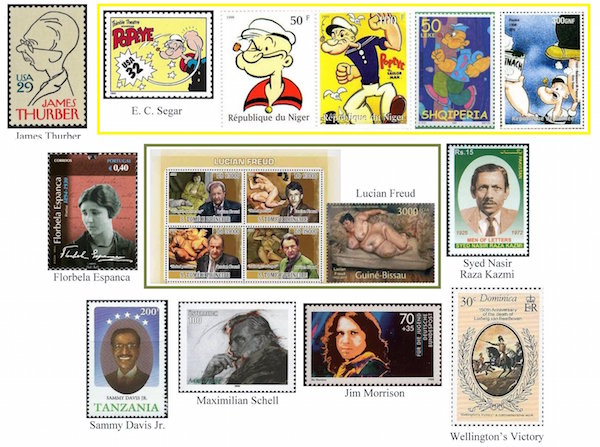
Pakistani poet Syed Nasir Raza Kazmi (8 December 1925 – 2 March 1972) was born in the Punjab and educated in Simla and Lahore, where he chose to live after the creation of Pakistan in 1947. He worked as a journalist and editor. His romantic and nature poems placed him among the most celebrated Urdu poets of his time. His early death from stomach cancer was followed by the publication of four more volumes of verse.
Given the superabundance of material today, I hope I can be forgiven for lumping together three popular entertainers, the irrepressible Sammy Davis Jr. (December 8, 1925 – May 16, 1990), the Swiss actor who first came to fame with his brilliant performance in Judgment at Nuremberg, Maximilian Schell (8 December 1930 – 1 February 2014), and lead singer of The Doors, Jim Morrison (December 8, 1943 – July 3, 1971).
Wellington’s Victory was a crowd-pleaser Beethoven wrote in June 1813 to mark the battle of Vitoria in Spain, in which the Duke of Wellington’s forces defeated those of the Emperor Napoleon’s brother Joseph. The work was written at the behest of Johann Nepomuk Maelzel, who wanted a piece for his new contraption the panharmonicon, a sort of mechanical orchestra. Beethoven also prepared a standard orchestral version, which he called a “Battle Symphony”, even though it’s in only one movement. (The terms “symphonic poem” and “tone poem” hadn’t been invented yet.) The first performance took place (along with the première of the Seventh Symphony) in Vienna on 8 December 1813 at a benefit concert for Austrian and Bavarian soldiers wounded at the Battle of Hanau, which had been fought at the end of October. Beethoven himself conducted. Among a set of Beethoven stamps from Dominica is one that specifically cites this piece, not one of the composer’s more profound efforts.
Surely deserving of a US stamp is the fine American poet and short story writer Delmore Schwartz (December 8, 1913 – July 11, 1966).
A graduate of the University of Massachusetts with a B.A. in English, Doug Briscoe worked in Boston classical music radio, at WCRB, WGBH, and WBUR, for about 25 years, beginning in 1977. He has the curious distinction of having succeeded Robert J. Lurtsema twice, first as host of WGBH’s weekday morning classical music program in 1993, then as host of the weekend program when Robert J.’s health failed in 2000. Doug also wrote liner notes for several of the late Gunther Schuller’s GM Recordings releases as well as program notes for the Boston Classical Orchestra. For the past few years he’s been posting a Facebook “blog” of classical music on stamps of the world, which has now been expanded to encompass all the arts for The Arts Fuse.

very nice and interesting Article on Art on stamps. It is great respect to the All Artists for their life achivement and success.